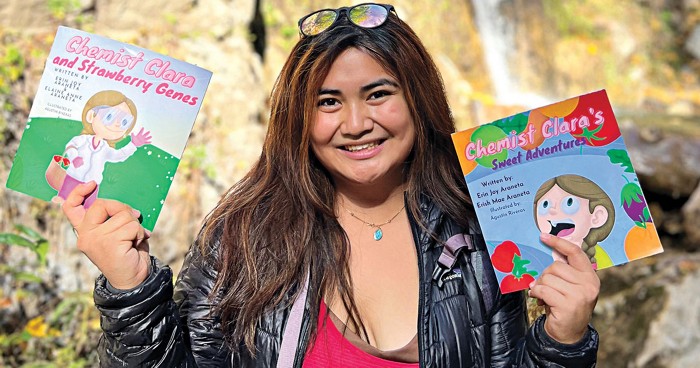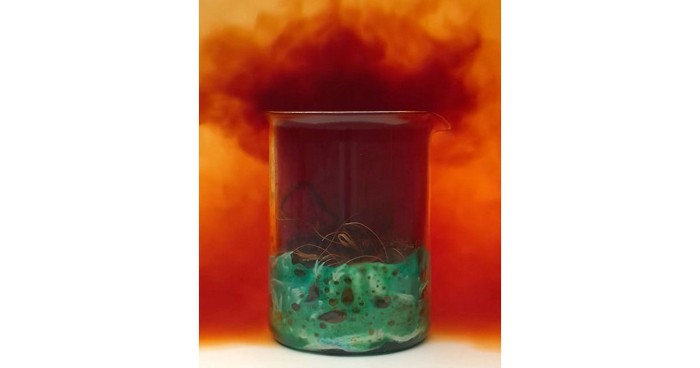Advertisement
Grab your lab coat. Let's get started
Welcome!
Welcome!
Create an account below to get 6 C&EN articles per month, receive newsletters and more - all free.
It seems this is your first time logging in online. Please enter the following information to continue.
As an ACS member you automatically get access to this site. All we need is few more details to create your reading experience.
Not you? Sign in with a different account.
Not you? Sign in with a different account.
ERROR 1
ERROR 1
ERROR 2
ERROR 2
ERROR 2
ERROR 2
ERROR 2
Password and Confirm password must match.
If you have an ACS member number, please enter it here so we can link this account to your membership. (optional)
ERROR 2
ACS values your privacy. By submitting your information, you are gaining access to C&EN and subscribing to our weekly newsletter. We use the information you provide to make your reading experience better, and we will never sell your data to third party members.
Education
Fostering Creativity
by Richard N. Zare
March 22, 2010
| A version of this story appeared in
Volume 88, Issue 12

The tradition of the Priestley Lectures is that some senior—sometimes very senior—member of the American Chemical Society gets up and addresses you. The Priestley Medal is not awarded on the basis of future promise but on promise fulfilled. I certainly take pride in my own accomplishments—from the use of laser-induced fluorescence in gases to its application to tiny volumes of solution to the study of single molecules in solution to helping sequence the human genome.
But a preobituary account of my life is not my cup of tea. Instead, I may be breaking a bit with precedent, but I want to speak to you about something more important than me. I want to speak to you about creativity and whether it is something that can be learned. Can anyone teach creativity? It seems to me that creativity is central to how we make advances in the chemical sciences. Yet it is so seldom discussed.
First, we must define what creativity is and is not. I think creativity is the process of forming original ideas. I can also tell you what it is not. Creativity is not about talent, not about skill, and not about intelligence. It is not about doing something better than someone else. Creativity is about thinking, risk taking, exploring, discovering, and imagining. What is important is that the idea is new to the person who conceives it. A search is required to determine whether the idea is truly original, in the sense that no one before has thought it up.
Can you teach creativity? Here, I am reminded of a favorite cartoon having three panels. The first panel shows two young boys with a spotted dog, which of course is named Stripe. The first boy is saying to the second boy, “I taught Stripe to whistle.” The second panel of the cartoon shows the second boy with his ear to Stripe’s mouth, saying, “Make him whistle; I don’t hear him whistling.” The last panel shows the reply from the first boy: “I said I taught Stripe how to whistle; I didn’t say Stripe learned it!”
To any of us on the academic side of chemistry, this situation is all too familiar. We can easily fool ourselves into thinking we are teaching someone something when we are not. Yet I believe that creativity can actually be taught, or at least fostered. Anyway, that is certainly what I tell my research group. In my lab, I try to create an environment that encourages risk taking.
It seems to me that creativity involves the intersection of three things: your capacity to think outside the box and put together existing ideas into new combinations; the knowledge, expertise, and information you have, without which you have nothing to put together; and your motivation to think about something different—that is, your intensity and willingness to accept change. Creativity requires passion, resources, and the daring to play with ideas and accept the risk that what you are doing might completely fail.
Let’s begin with the concept of thinking outside the box. The best example I know is a problem I first encountered in grade school. You have a square three-by-three array of circles on a piece of paper, Figure 1, and you are asked to draw four connected straight lines that go through every circle. The beginner usually starts by drawing straight lines along the periphery of the square, setting off from one corner, followed by an extra line to end on the center circle, Figure 2. This requires five lines and is not a solution.
Then, the same procedure is repeated by starting at another corner but, by symmetry, fails again. Sometimes this is followed by picking a corner and drawing a diagonal line to start, but this approach fails even worse because it requires six lines, Figure 3.
The correct solution is to realize that the first line need not start or stop on the center of a circle in the periphery of the square array but instead can overshoot—that is, you must literally go outside the box, Figure 4. This solution is representative of creative thinking. It casts off a hidden assumption that the connected lines must be confined to the perimeter of the square array.
But let’s continue to play with this problem. Is it possible to go through every circle with only three connected straight lines? Your first response might be that this is impossible because parallel lines cannot meet. With a little more thought, however, you realize the problem never stipulated that the lines must go through the center of each circle; that was just another hidden assumption. One solution is shown in Figure 5.
Now let’s think way, way outside the box. Is it possible for only one straight line to pass through all the circles? Yes, it is. Moreover, you can succeed in more than one way. The first way is to realize that nothing in the problem defines how thick the line is; with a line that is as thick as the whole array, the solution becomes an easy matter—just one swipe of a paintbrush, so to speak.
Suppose, however, that you are given an extra requirement that the thickness of the line cannot exceed the diameter of a circle. What would you do then? As long as you are stuck in two-dimensional Euclidean geometry, there appears to be no solution, but if you can break out of this constraint, a solution is possible. For example, if you place the piece of paper containing the three-by-three array of circles on a cylinder, you can proceed with one straight line to spiral around and around the surface and cover each circle, Figure 6. I think that this type of reasoning illustrates what is needed to be a creative problem solver: a combination of playfulness, determination, and questioning of implicit assumptions about how the problem is supposed to be solved.
I believe that there actually exists a creativity cycle. It begins with inertia. You recognize that some problem might exist, but you have no idea what to do about it or whether it is worth considering. You accept what already is known and feel pretty good about your understanding of the nature of the world, even if incomplete.
The next stage is irritation. The inertia stage can last a long time, but some discomfort gradually grows to a point where you recognize a real problem. You commit yourself to trying to solve the problem. It really is true that pearls come only from irritated oysters. You must break out of the inertia stage for creativity to happen. Being well adjusted and being creative do not easily go together.
Often, the next stage is imitation. You try an approach that you are told worked for others who solved similar problems. Aspiring artists first learn to paint by copying the masters, and I believe imitation is similarly valuable in scientific research. Or you might imitate yourself—try a strategy that has worked for you before. The more different types of problems you solve, the more you are prepared to solve new ones. Imitation is a safe way to begin exploration. But we must not become so attached to what has been done before that we fail to question everything.
This questioning leads to the next stage, which I call intuition. It is a stage full of fear and excitement, and it requires you to adopt an attitude of playfulness. You put forward wild hypotheses, and then you work to show how these hypotheses are ridiculous. Two extremes must be avoided. If you believe too much and do not question, you can easily delude yourself. On the other hand, if you are too critical, you do not dare to try anything. You need to become what I call a “contented schizophrenic,” believing and doubting at the same time.
The contented schizophrenic can accept a messy situation and even revel in its ambiguity. All that is needed is an unfettered imagination. You follow your hunches and see where they lead. You accept that most of the time you will fail—fail miserably—but you do not fear failure. Instead, you regard past failures as guides to successful problem solving. You accept that all the pieces of a puzzle may not fit together at once; some so-called facts may turn out to be artifacts or fiction.
Then comes a moment of inspiration. You see some crazy connections or interconnections that were not realized before. Eureka! The problem is solved. It is a moment of ecstasy. This feeling is to be treasured. Once experienced, it will drive you on to try the next difficult problem, and this creativity cycle will repeat itself.
Creativity comes into play when you care about some problem passionately and you become actively involved in finding its solution. You search for possible connections, keep your mind open to different possibilities, and bring your broad knowledge to bear on ways of approaching the problem. A combination of passion, persistence, and playfulness is a powerful means of turning accidental discoveries of the laboratory into breakthroughs. And once you have this frame of mind, you can go on to solve all types of problems.
Two key ingredients seem essential for creativity to occur. The first prerequisite is confidence: You believe that you can solve your problem. The second is passion: You believe that trying to solve this problem is one of the most important things you are doing in your life.
The confidence comes only from practice in solving other problems and finding that you can. No one learned to play a musical instrument by reading a book or attending a lecture on how to play a musical instrument. The learning involves practice and hard work.
The passion comes from many sources that probably differ from person to person. I know in my own case it started out as a drive to prove my worth to my parents, but now an important source of passion for me is the true pleasure I feel in sharing with others any discovery of mine. Yes, I am curious about things, but I know it is not curiosity alone that drives me. I wonder what it is like for you. And I wonder how many artists would paint if they could not show their paintings to others, or how many composers would write music if they could not share it with listeners. Finding out something new is not sufficient for me; it must also be communicated.
I think it is this sense of sharing new knowledge that makes the science community so special and wonderful. It’s been a great time to have been a chemist, and I hope it will continue. I have been fortunate to live in an age that supported scientific inquiry with much less emphasis on meeting immediate social needs or fixing glaring social problems than the present; an age that rewarded excellence in pursuing the discovery process.
As for creativity, I am not sure whether it can be fully taught, but I do believe it can be fostered. It certainly requires the right environment. I was fortunate enough to be put into that rarefied atmosphere as an undergraduate student with Professor William Klemperer as my adviser at Harvard University and then as a graduate student with Professor Dudley R. Herschbach as my mentor first at the University of California, Berkeley, then at Harvard. It was then that I began to absorb what scientific creativity really is, and I have tried to pass that spirit along to my own research group through faculty positions I have held at Massachusetts Institute of Technology, the University of Colorado, Columbia University, and now Stanford University. And it is to my own research group members and coworkers that I give thanks—because the work that they have done is why I appear before you as your Priestley Medalist. I am deeply honored to accept this award, and I thank you for the opportunity to speak to you.







Join the conversation
Contact the reporter
Submit a Letter to the Editor for publication
Engage with us on Twitter